As an Amazon Associate KitchenwareSets.com earns from qualifying purchases.
9 Brilliant Cheap Outdoor Kitchen Ideas You Can Actually DIY
Dreaming of sizzling burgers and summer cocktails prepared in your own backyard oasis, but shuddering at the thought of a five-figure price tag? You’re not alone. The glossy magazine photos of sprawling outdoor kitchens with granite countertops and high-end stainless steel appliances can make it seem like a luxury reserved for the wealthy.
This often leads to “analysis paralysis,” where the dream feels so out of reach that you never even start. You might think you’re stuck with a lonely grill on a cracked patio slab forever, missing out on the joy of creating a true outdoor living and entertaining space. But what if you could build a stylish, functional, and durable outdoor kitchen for a fraction of the cost?
Here’s the secret: building a cheap outdoor kitchen is entirely achievable by focusing on smart material choices and embracing the power of DIY labor. The most cost-effective and popular methods involve using a simple pressure-treated wood frame, ultra-sturdy cinder blocks, or cleverly repurposed furniture, combined with budget-friendly countertops like poured concrete or tile.
Dreaming of an Outdoor Kitchen Without the Hefty Price Tag?
It’s one of the most common backyard renovation dreams, but the perceived cost is a major hurdle. We get it. That’s why we’ve spent countless hours researching and testing budget-friendly building methods, from repurposing salvaged materials to finding the most durable low-cost options, to bring you a list of ideas that truly work. Forget the intimidating quotes; this is about empowering you to create an amazing space with your own two hands.
Planning Your Budget-Friendly Outdoor Kitchen
Before you buy a single 2×4 or cinder block, a solid plan is your most valuable tool. In my experience, skipping this step is the number one reason projects go over budget or stall out. Experts agree that a detailed plan is what prevents costly mistakes and frustrating mid-project changes. Here are the three critical first steps:
- Assess Your Space: Get out a tape measure. How much room do you really have? Is it a long, narrow side yard, a small square patio, or a corner of a deck? Your available space will dictate your layout. A simple straight-line or L-shaped layout is often the most space-efficient and budget-friendly.
- Set a Realistic Budget: “Cheap” means different things to different people. Write down the absolute maximum you’re willing to spend. Then, itemize the essentials: a grill, a countertop/prep surface, and the frame material. Everything else—a sink, storage, a mini-fridge—is an add-on you can tackle later.
- Choose Your Core Components: You don’t need everything at once. The foundation of any great outdoor kitchen is a reliable grill and a decent amount of prep surface. Start there. You can design your DIY build around a freestanding grill you already own or frame it for a drop-in model.
9 Brilliant Cheap Outdoor Kitchen Ideas You Can Actually DIY [Updated for 2025]
Ready for some real-world inspiration? The beauty of a DIY outdoor kitchen is the ability to customize it to your exact needs and budget. We’ve curated these nine ideas based on real-world projects known for their affordability, durability, and successful outcomes. Each one uses simple materials and techniques that are well within the reach of a determined DIYer.
1. The Ultra-Sturdy Cinder Block BBQ Island
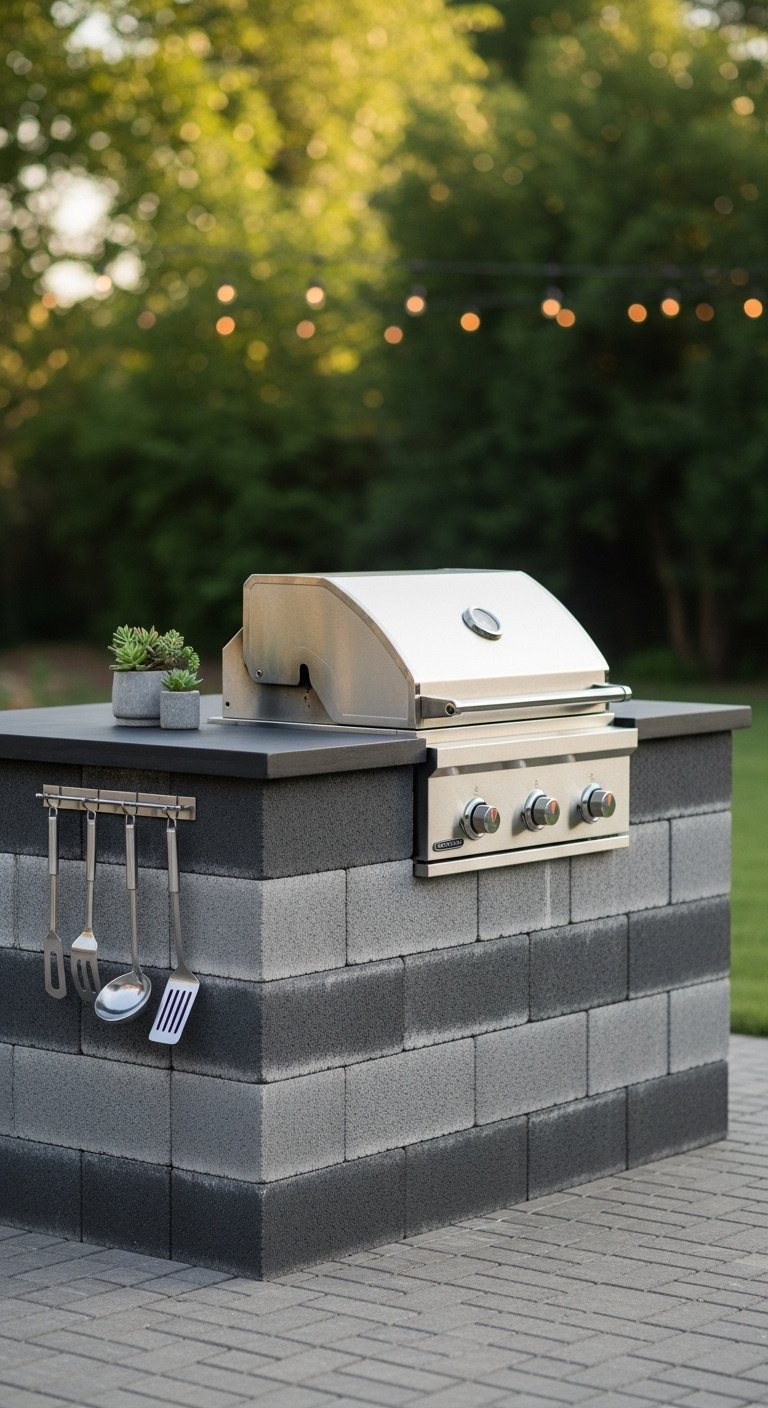
For a rock-solid, non-combustible, and incredibly cheap frame, nothing beats the simplicity and strength of cinder blocks. This method is like building with adult-sized LEGOs and requires no complex cuts or joinery.
- Materials Needed: Cinder blocks, landscape block adhesive, level, tape measure, concrete pavers or pre-cast concrete slab for countertop, drop-in grill.
- Step-by-Step Directions:
- Level the ground where your island will be built. A base of packed gravel is ideal.
- Lay the first course of cinder blocks in your desired shape (e.g., a simple rectangle), leaving a perfectly measured opening for the grill. Use a level to ensure it’s perfect from every angle.
- Apply landscape block adhesive along the top of the first course and stack the next layer, staggering the joints like bricks for maximum strength.
- Continue building up to your desired counter height, which is typically 36 inches.
- Place your concrete paver or slab countertop on top, securing it with a generous amount of adhesive.
- Carefully lower your drop-in grill into the designated opening according to the manufacturer’s instructions.
Pro Tip: Before you start, dry-stack the blocks to finalize your layout and ensure your grill will fit perfectly. This avoids wasting adhesive and having to rebuild. I learned this the hard way on my first masonry project!
Pin this durable design to your ‘Backyard Projects’ board!
2. The Rustic Repurposed Pallet Grill Station
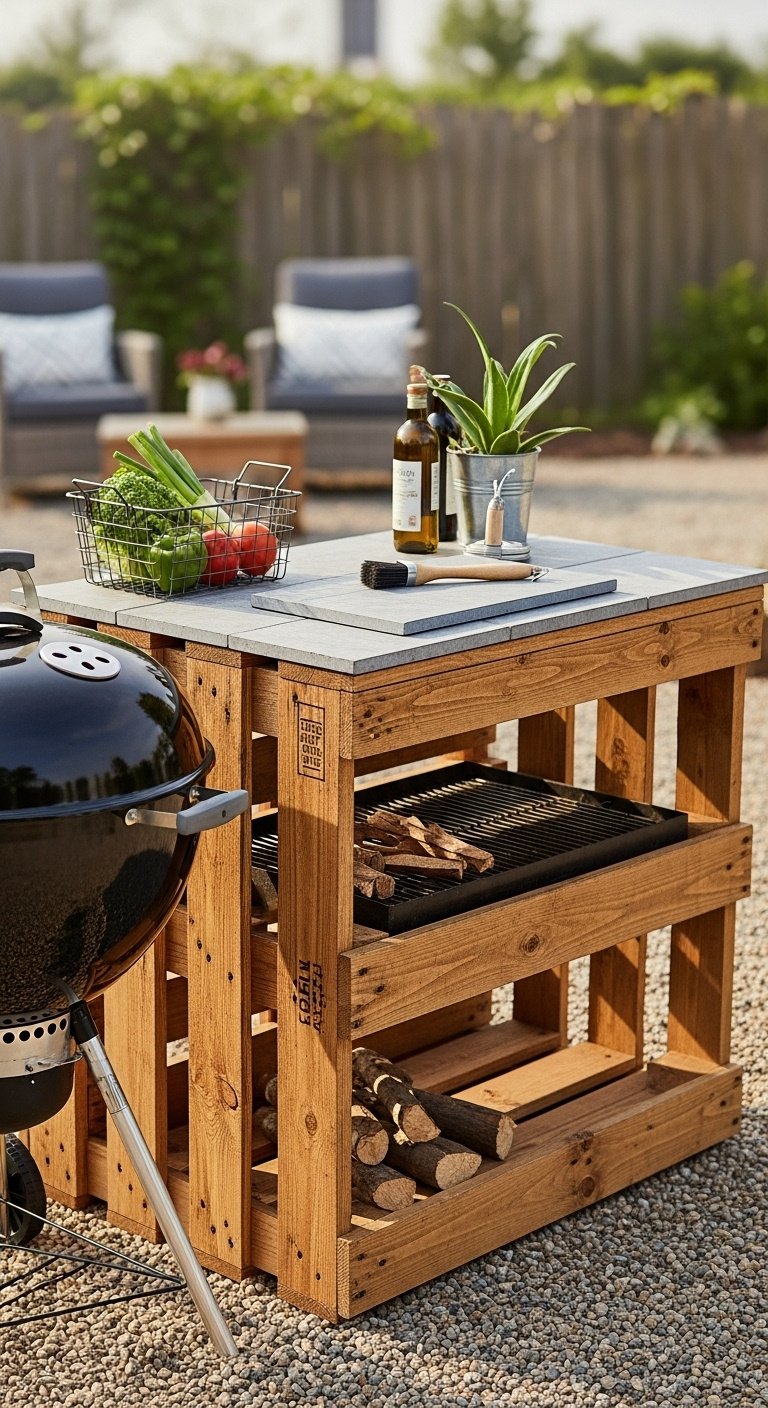
For a super cheap, rustic-chic solution, using heat-treated wood pallets creates a functional grill stand with prep space for next to nothing. This is the ultimate upcycling project for your backyard.
- Materials Needed: 2-3 heat-treated (marked “HT”) wood pallets, orbital sander, screws, drill, weatherproof wood stain, a large tile or small sheet of metal for a heat-safe prep surface.
- Step-by-Step Directions:
- Thoroughly clean the pallets with a stiff brush and soapy water, then let them dry completely. Sand every surface to remove splinters and rough spots.
- Stand one pallet upright to serve as the back. Screw a second pallet horizontally to the first to create the main counter surface.
- Use wood from a third pallet (deconstructed) to create legs for support and add a lower shelf for storage.
- Apply at least two coats of a high-quality weatherproof stain or sealer to protect the wood from the elements.
- Secure the tile or metal sheet to the countertop with construction adhesive to create a safe, heat-resistant, and easy-to-clean prep area next to your grill.
Lesson Learned: Always use heat-treated (HT) pallets, not chemically treated (MB) ones, for any project involving food preparation. The stamp is usually burned into the side of the pallet blocks. It’s a critical safety check!
Love upcycling? Save this rustic idea to your ‘DIY Pallet Ideas’ board!
3. The Modern DIY Poured Concrete Countertop
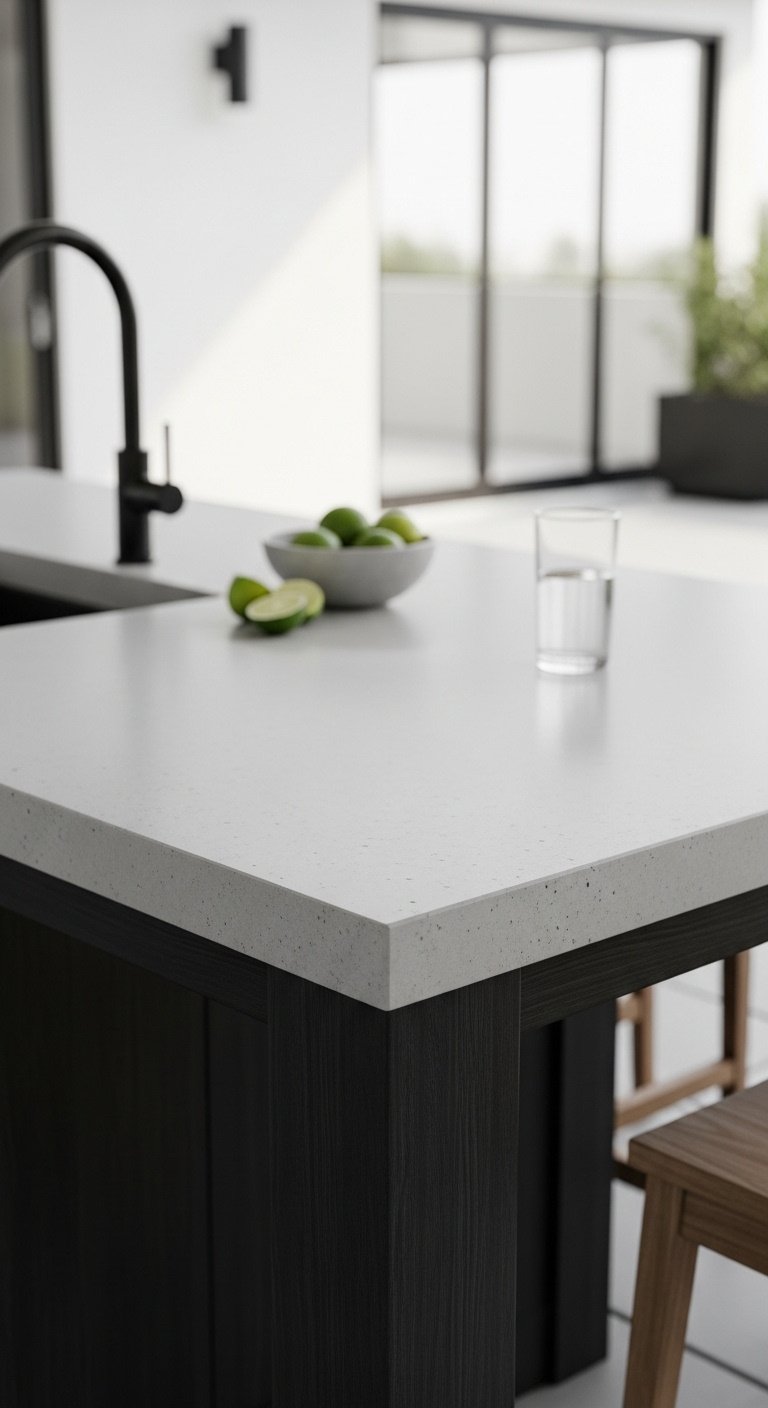
To get a high-end, modern look for less, pouring your own concrete countertop gives you a custom, durable surface for a fraction of the cost of stone. It’s a rewarding project that looks incredibly professional when done right.
- Materials Needed: Melamine board, silicone caulk, high-strength concrete mix (e.g., Quikrete 5000), wire mesh or rebar for reinforcement, food-safe concrete sealer, trowel, orbital sander.
- Step-by-Step Directions:
- Build a mold for your countertop to your exact dimensions using melamine board, screwing the sides securely into the base.
- Seal the inside seams of the mold with a bead of silicone caulk. Smooth it with your finger to create clean, slightly rounded edges on your final countertop.
- Mix the concrete according to the package directions until it reaches a consistent, oatmeal-like texture.
- Pour the concrete into the mold, filling it halfway. Gently place the wire mesh reinforcement inside, then pour the rest of the concrete on top.
- Vibrate the mold by tapping the sides and bottom with a rubber mallet or using a sander (without sandpaper) to release trapped air bubbles. Trowel the surface as smooth as possible.
- Let it cure for several days as recommended by the manufacturer. Once fully cured, carefully remove the mold, sand any rough spots, and apply several coats of a food-safe concrete sealer.
Pro Tip: For a professional, polished finish, wet-sand the cured countertop with progressively finer grits of sandpaper (from 100 up to 400 grit) before you apply the sealer. This one step is what takes it from a DIY project to a stunning centerpiece.
Get this high-end look for less! Pin this concrete countertop tutorial now.
4. The Upcycled Cabinet Kitchen Base
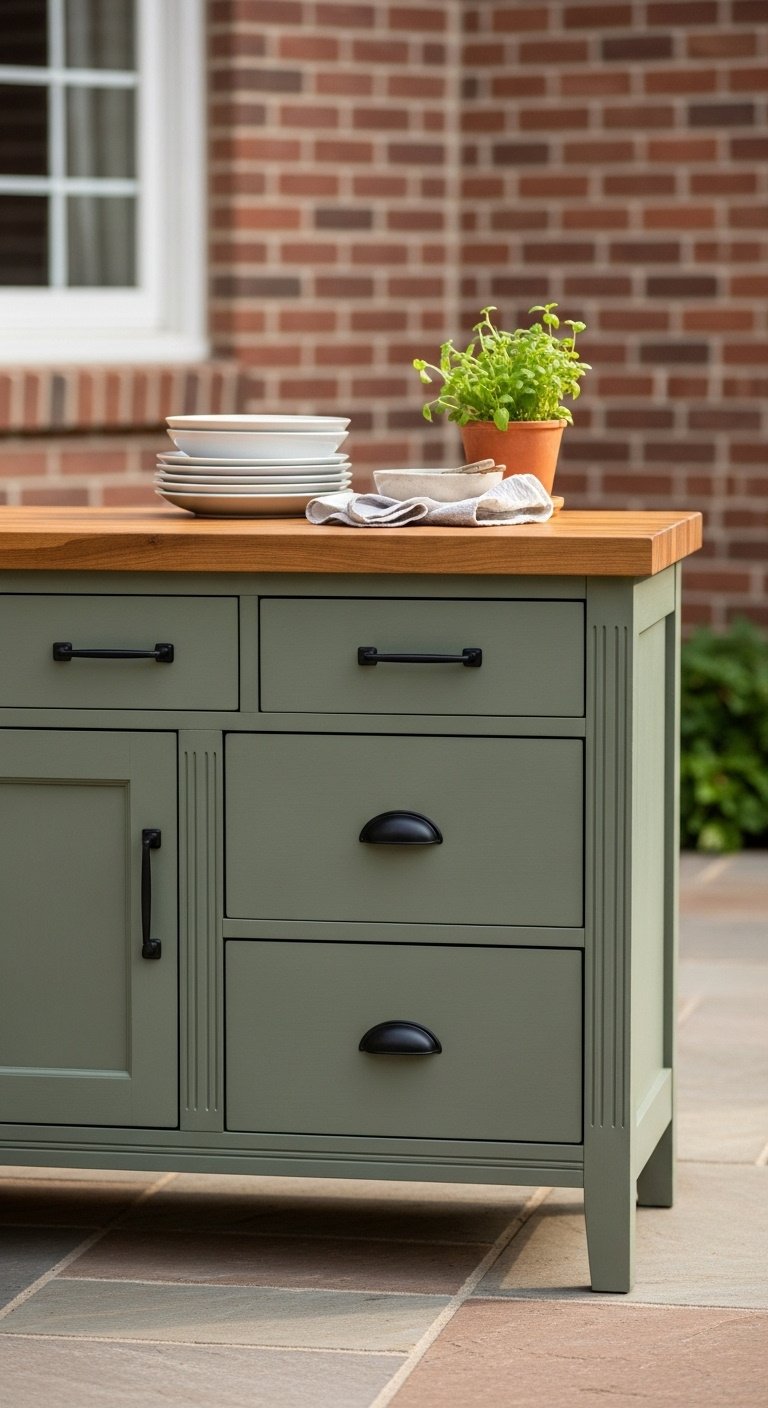
For a creative and simple base with built-in storage, upcycling an old piece of solid wood furniture is a brilliant shortcut. A sturdy old dresser, sideboard, or cabinet can be transformed into a beautiful and functional island.
- Materials Needed: An old wooden dresser or cabinet, sander, exterior-grade primer, marine-grade exterior paint, new hardware (optional), countertop material (e.g., a sealed piece of butcher block or a large format tile).
- Step-by-Step Directions:
- Find a sturdy, solid wood cabinet or dresser from a thrift store, marketplace, or even your own home. Avoid particle board.
- Remove all hardware. Thoroughly clean and sand the entire piece to scuff up the old finish.
- Apply one to two coats of a high-quality exterior primer designed to block moisture and tannin bleed.
- Paint the cabinet with several thin coats of marine-grade or durable exterior paint for maximum weather resistance.
- Re-install the old hardware after cleaning it, or add new, weather-resistant pulls and knobs for an updated look.
- Measure and cut your countertop material to size, allowing for a slight overhang. Secure it to the top of the cabinet from underneath with screws and brackets.
Lesson Learned: Don’t skip the marine-grade paint. I once used standard exterior paint on a project like this, and it started peeling within a year. Marine paint is designed for boats and will hold up much better to the direct exposure and moisture of an outdoor kitchen.
Turn trash into treasure! Save this upcycling idea for your next project.
5. The Minimalist Grill & Prep Table Combo
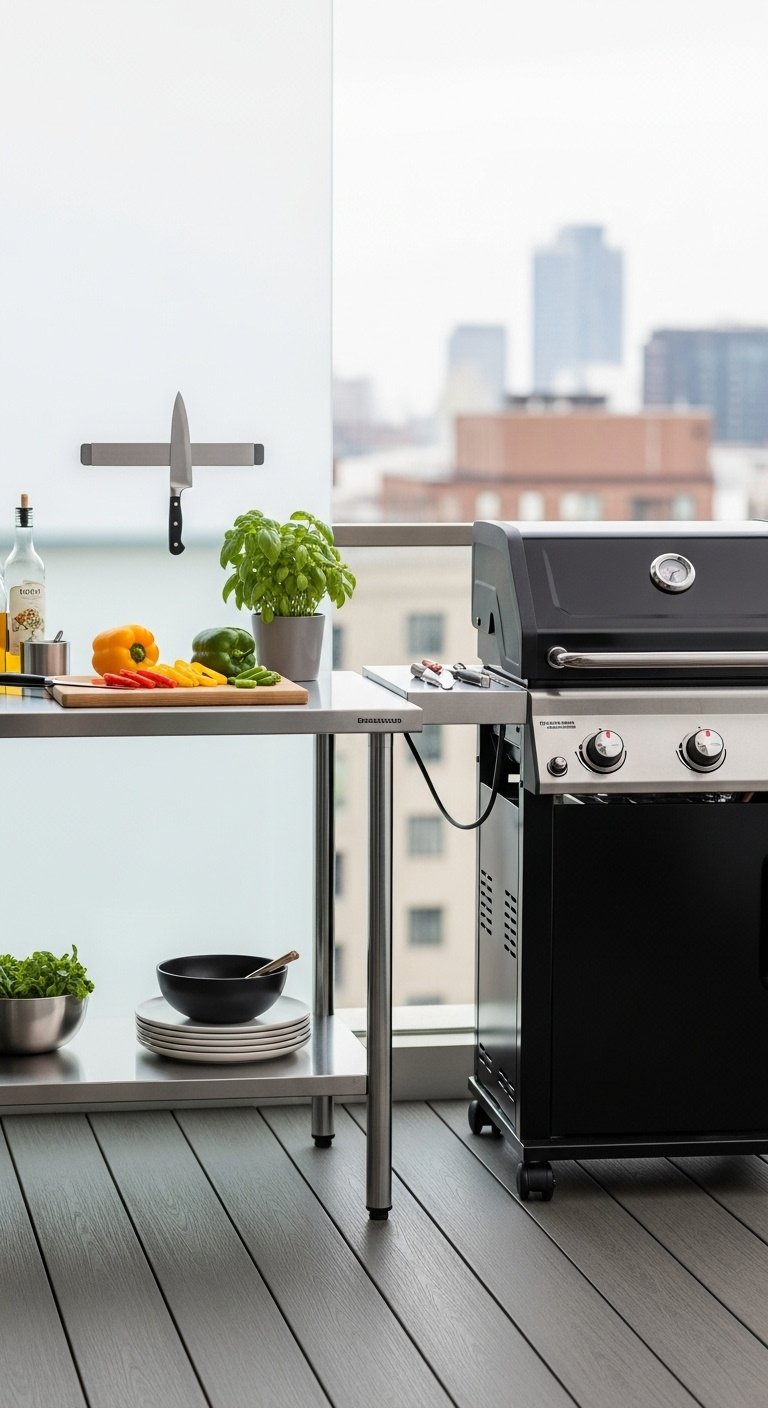
If you’re tight on space or want a non-permanent solution, a simple freestanding grill paired with a sturdy work table creates an efficient kitchen zone without any construction. This is perfect for renters or small patios.
- Materials Needed: Your existing freestanding grill, a sturdy work table (like an IKEA Bror or a stainless steel restaurant prep table), S-hooks, wall-mounted shelving or a magnetic knife strip.
- Step-by-Step Directions:
- Position your freestanding grill on your patio or deck, ensuring it’s a safe distance from the house siding.
- Place the work table next to the grill. A table with a lower shelf is a huge bonus for storing charcoal, wood chips, or a small cooler.
- Mount a floating shelf or a magnetic knife strip on the wall behind the table to store spices, plates, and tools, which frees up valuable counter space.
- Use S-hooks on the side of the table or on a wall-mounted rail to hang grilling utensils, towels, and oven mitts for easy access.
- This minimalist approach creates a highly functional, efficient, and non-permanent “kitchen zone.”
Pro Tip: Look for used commercial kitchen prep tables on restaurant supply sites or local marketplaces. They are made from stainless steel, are incredibly durable, super easy to clean, and often cheaper than residential “outdoor kitchen” carts.
Perfect for small spaces! Pin this minimalist kitchen idea.
6. The Quick & Easy Tiled Countertop Island
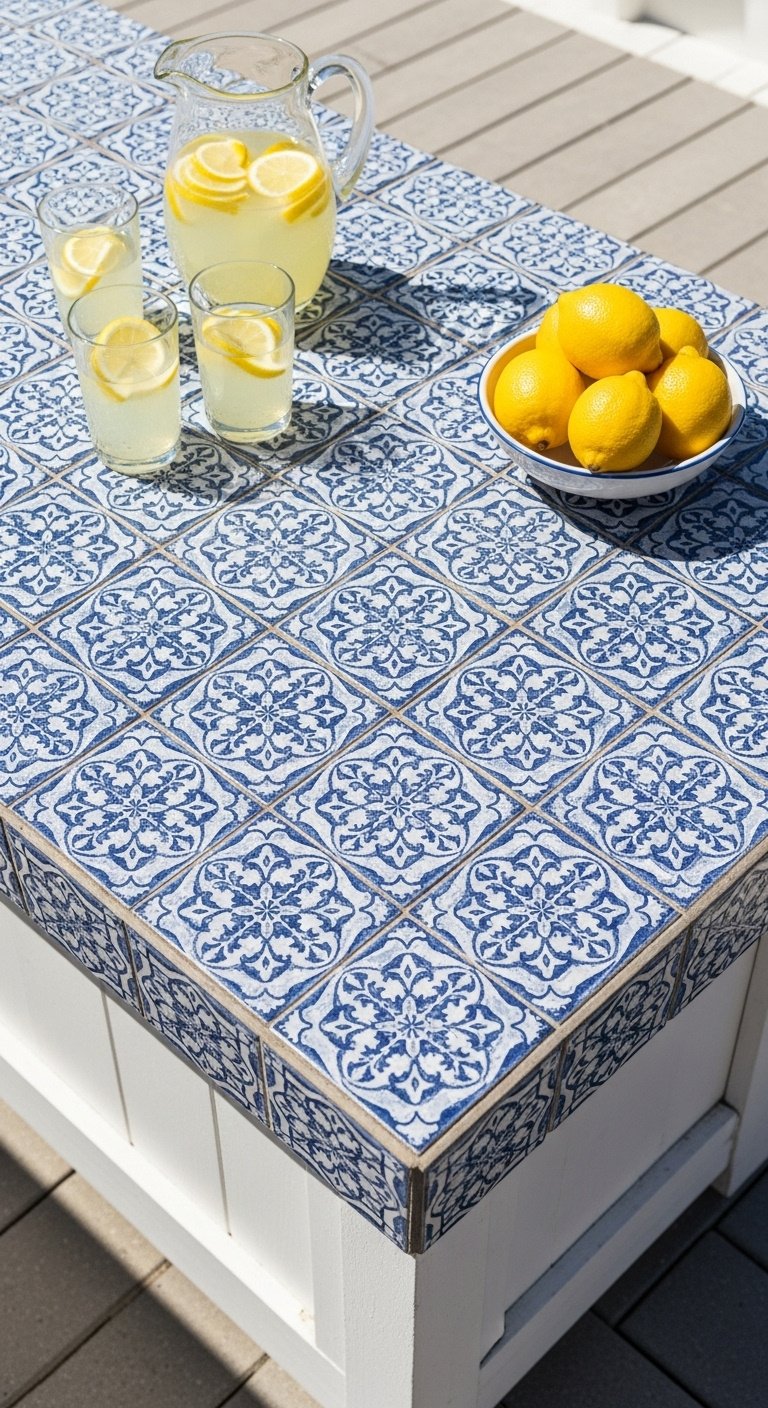
For a custom-sized countertop with a pop of color, building a simple frame and covering it with tile is a fantastic budget option. It’s durable, stylish, and you can find affordable tiles to match any aesthetic.
- Materials Needed: Pressure-treated lumber for the frame, cement backer board, backer board screws, porcelain tiles, thin-set mortar, tile trowel, exterior-grade grout, grout float, tile saw (can be rented).
- Step-by-Step Directions:
- Build a simple, sturdy box frame for your island using pressure-treated 2x4s.
- Cut cement backer board to size and screw it onto the top and sides of the frame. Tape and mud the seams with thin-set mortar for a seamless surface.
- Plan your tile layout, starting from the center and working outwards to ensure a balanced look.
- Apply a layer of thin-set mortar to a small section of the backer board with the notched side of your trowel.
- Firmly press the tiles into the mortar, using tile spacers for even gaps. Cut tiles as needed with a rented wet tile saw. Let the mortar set for 24 hours.
- Mix and apply the exterior-grade grout, pressing it into the gaps with a grout float. Wipe away the excess with a damp sponge and let it cure completely before use.
Pro Tip: Choose porcelain tiles over ceramic ones for outdoor projects. Porcelain is much denser and absorbs less water, making it far more resistant to cracking during the freeze-thaw cycles common in colder climates.
Add a pop of color! Save this beautiful tile idea to your ‘Patio Design’ board.
7. The Modular Sink & Storage Solution
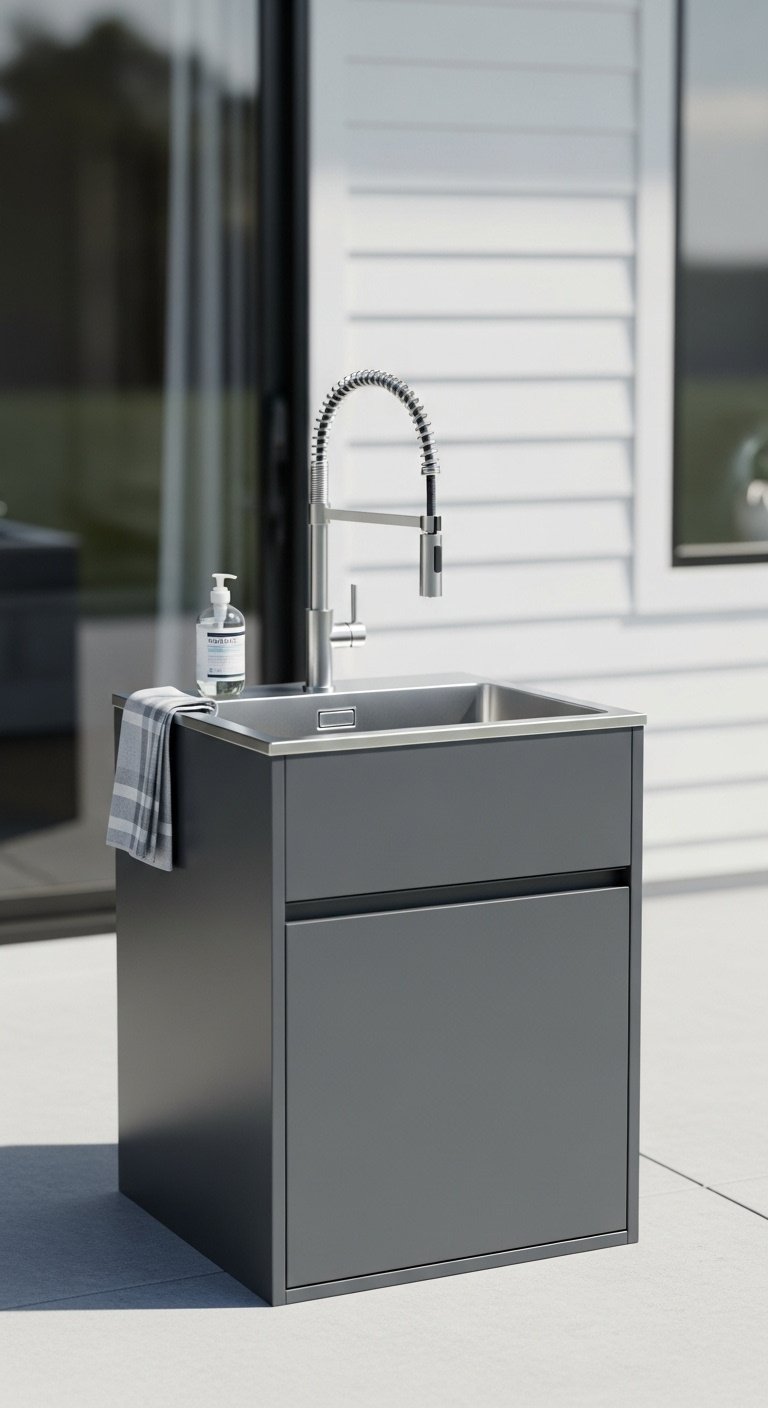
To add the convenience of a sink without complex plumbing, a prefabricated modular sink unit is a brilliant all-in-one solution. These units connect directly to a garden hose and offer valuable storage.
- Materials Needed: A prefabricated outdoor kitchen sink module, a garden hose with a Y-splitter, a bucket or a short drainage hose.
- Step-by-Step Directions:
- Purchase a modular outdoor sink unit online or from a home improvement store. They often come flat-packed for easy transport.
- Assemble the unit according to the manufacturer’s instructions, which typically involves just screwing a few panels together.
- Place the unit in your desired location on a level surface.
- Connect a standard garden hose to the faucet’s adapter. Using a Y-splitter on your spigot allows you to have the sink hose and a regular hose connected at the same time.
- For drainage, simply place a bucket under the sink’s drain pipe or attach a simple vinyl tube to direct the greywater to a nearby garden bed or drain.
Lesson Learned: While these units are incredibly convenient, pay close attention to the materials. Ensure the one you buy is made from weather-resistant materials like polypropylene, stainless steel, or powder-coated metal, not interior-grade particle board which will swell and disintegrate in the rain.
Want an easy upgrade? Pin this simple sink solution!
8. The Salvaged Material Masterpiece

For a truly unique and eco-friendly kitchen, building with found and salvaged materials can be virtually free. This approach requires creativity and flexibility, letting the materials guide your design.
- Materials Needed: Whatever you can find! Look for old fence pickets, discarded 4×4 posts, solid core doors, leftover bricks or pavers, and corrugated metal sheets. You’ll also need screws and a good exterior sealant.
- Step-by-Step Directions:
- Design your kitchen around the materials you have. A sturdy frame can be built from old 4×4 posts or reclaimed lumber.
- Use reclaimed fence pickets or aged corrugated metal as cladding for the sides of your kitchen island for a rustic, textured look.
- A solid core wood door, when sanded down and sealed with multiple coats of marine varnish, makes an excellent and surprisingly spacious countertop.
- Create a base or floor for the kitchen area using mismatched, salvaged bricks or pavers for a charming, eclectic look.
- The key is creativity: let the materials you find dictate the final design. It’s a fun and rewarding challenge.
Pro Tip: Always thoroughly inspect salvaged wood for rot, pests, and hidden nails before using it. A good cleaning with a pressure washer and a heavy-duty outdoor sealant are absolutely non-negotiable for ensuring the longevity of your masterpiece.
Love a creative challenge? Pin this ultimate recycled kitchen idea!
9. The Simple Wood Frame & Cladding Build
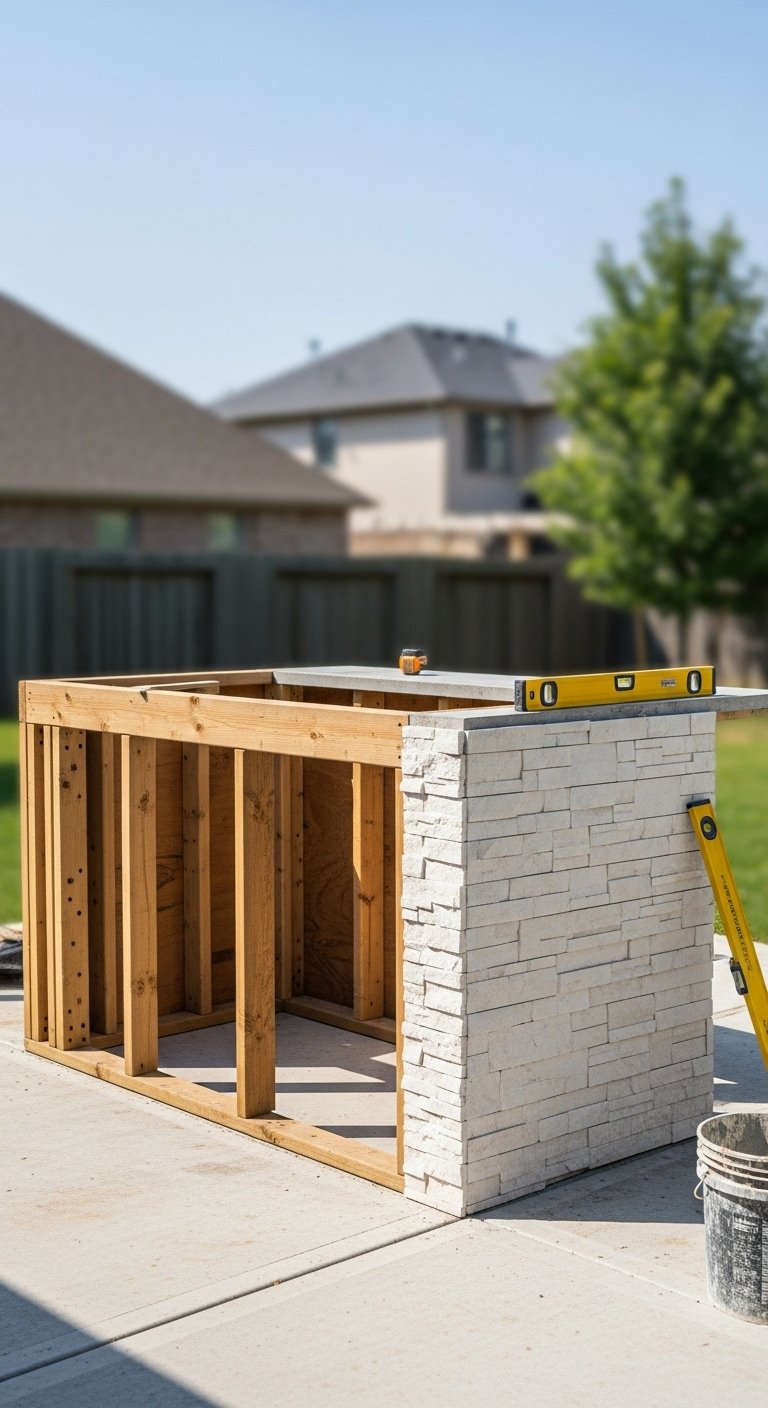
This is the most common and versatile DIY method, building a frame from pressure-treated lumber and covering it with a finish material. This allows you to create a fully custom kitchen that looks professionally built.
- Materials Needed: Pressure-treated 2×4 lumber, exterior-grade screws, cement backer board, cement board screws, your choice of finish (e.g., stone veneer sheets, stucco, tile), and mortar.
- Step-by-Step Directions:
- Design your kitchen layout and build a box frame using pressure-treated 2x4s, creating openings for your grill and any other appliances. It’s very similar to framing a small wall.
- Cover the entire exterior of the wood frame with cement backer board, attaching it with specialized screws. This creates a non-combustible, water-resistant, and stable surface for your finish.
- Apply your chosen finish. For stone veneer, you’ll apply a scratch coat of mortar, let it dry, then apply more mortar to “butter” the back of the stones and press them firmly onto the board.
- Once the finish is complete and fully cured, install your countertops and slide your appliances into place.
Lesson Learned: This is the most customizable but also the most complex method. While the framing and finishing are very DIY-friendly, if you plan to connect permanent gas or electricity, always hire a licensed professional for those specific tasks. It’s a matter of safety and code compliance.
Ready to build from scratch? Pin this step-by-step guide!
Key Takeaways: Your Quick Guide to a Budget Outdoor Kitchen
Feeling inspired? Here are the core principles to remember as you start planning your project.
- DIY is King: The single biggest cost saving in any outdoor kitchen project comes from providing your own labor.
- Embrace Simple Materials: Cinder blocks, repurposed wood, pallets, and concrete are your best friends for budget-friendly and durable construction.
- Plan First, Build Second: A solid plan for your layout and materials prevents expensive mistakes and frustrating mid-project changes.
- Start with the Essentials: A grill and a prep surface are all you truly need to get started. You can always add a sink, fridge, or extra storage later on.
- Prioritize Durability: Always use weather-resistant materials like pressure-treated wood, porcelain tile, and exterior-grade sealants to make your investment last for years.
People Also Ask About Cheap Outdoor Kitchen Ideas
You’ve got questions, and we’ve got answers. Here are some of the most common queries we see about building an outdoor kitchen on a budget.
What is the cheapest way to build an outdoor kitchen?
The absolute cheapest way is to build a simple grill station using repurposed materials like heat-treated pallets or an upcycled dresser. For a more permanent structure, a DIY cinder block frame with a poured concrete countertop offers incredible durability for a very low material cost, especially if you provide the labor yourself.
What is the best material to use for a budget outdoor kitchen?
For the frame, pressure-treated wood or cinder blocks are the most budget-friendly and durable options. For countertops, poured-in-place concrete or porcelain tile over a cement backer board offer a high-end look for a low price. Avoid using untreated wood and expensive natural stone like granite to keep your costs down.
Do I need a permit to build a simple outdoor kitchen?
You typically do not need a permit for a simple, non-permanent structure like a grill cart or a small island with no connected utilities. However, if your project involves running new electrical lines, permanent plumbing for a sink, or a natural gas line, you will almost certainly need a permit. When in doubt, always check with your local building authority first.
How can I make an outdoor kitchen in a small space?
For small spaces, focus on verticality and multi-functionality. A simple grill and a narrow prep table (like a stainless steel cart) form a great base. Use wall-mounted shelves, magnetic knife strips, and hanging hooks to store tools and supplies, which keeps your limited counter space clear for cooking and prep.
Final Thoughts
Creating the outdoor kitchen of your dreams doesn’t have to drain your bank account. The reality is that with a little creativity, some elbow grease, and smart choices with materials, you can build a beautiful, functional space for cooking and entertaining that you’ll be proud of for years to come. It’s about making your backyard work for you and extending your living space into the outdoors.
Which of these cheap outdoor kitchen ideas has sparked your creativity for your own backyard project? Let us know in the comments below
